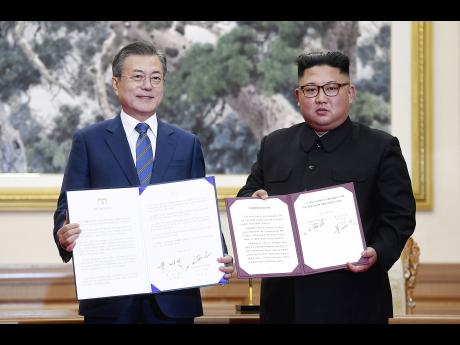Kim agrees to dismantle main nuke site if US takes steps too
PYONGYANG (AP)
The leaders of North and South Korea announced a wide range of agreements Wednesday that they said were a major step toward peace on the Korean Peninsula. But the premier pledge on denuclearisation contained a big condition, with North Korean leader Kim Jong-un stating that he would permanently dismantle his main nuclear complex only if the United States takes unspecified corresponding measures.
Compared to the vague language of their two summits earlier this year, Kim and South Korean President Moon Jae-in agreed in their second day of meetings to an ambitious programme meant to tackle soaring tensions last year that had many fearing war as the North tested a string of increasingly powerful weapons.
Kim promised to accept international inspectors to monitor the closing of a key missile test site and launch pad and to visit Seoul soon, and both leaders vowed to work together to try to host the Summer Olympics in 2032.
But while containing several tantalising offers, their joint statement appeared to fall short of the major steps many in Washington have been looking for - such as a commitment by Kim to provide a list of North Korea's nuclear facilities, a solid step-by-step timeline for closing them down, or an agreement to allow international inspectors to assess progress or discover violations.
It also was unclear what "corresponding steps" North Korea wants from the US to dismantle its nuclear site.
The question is whether it will be enough for US President Donald Trump to pick up where Moon has left off. Trump told reporters Wednesday that the outcome of the summit was "very good news" and that "we're making tremendous progress" with North Korea. He didn't indicate in his brief remarks whether the US would be willing to take further steps to encourage North Korean action on denuclearisation.
Declaring they had made a major step toward peace, Moon and Kim stood side by side as they announced their joint statement to a group of North and South Korean reporters after a closed-door meeting Wednesday morning. They took no questions.
"We have agreed to make the Korean Peninsula a land of peace that is free from nuclear weapons and nuclear threat," Kim said at the guesthouse where Moon is staying. "The road to our future will not always be smooth and we may face challenges and trials we can't anticipate. But we aren't afraid of headwinds because our strength will grow as we overcome each trial based on the strength of our nation."
Kim and Moon earlier smiled and chatted as they walked down a hallway and into a meeting room to finalise the joint statement, which also said that the leaders would push for a Korean Peninsula without nuclear weapons and to "eliminate all the danger of war." Moon and Kim planned to visit a volcano sacred to the North today, the last day of Moon's visit.
This week's summit comes as Moon is under increasing pressure from Washington to find a path forward in efforts to get Kim to completely - and unilaterally - abandon his nuclear arsenal.
Trump has maintained that he and Kim have a solid relationship, and both leaders have expressed interest in a follow-up summit to their meeting in June in Singapore. North Korea has been demanding a declaration formally ending the Korean War, which was stopped in 1953 by a cease-fire, but neither leader mentioned it Wednesday as they read the joint statement.
In the meantime, however, Moon and Kim made concrete moves of their own to reduce tensions on their border.
According to a statement signed by the countries' defense chiefs, the two Koreas agreed to establish buffer zones along their land and sea borders to reduce military tensions and prevent accidental clashes. They also agreed to withdraw 11 guard posts from the Demilitarised Zone by December and to establish a no-fly zone above the military demarcation line that bisects the two Koreas that will apply to planes, helicopters and drones.

